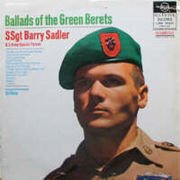 Barry Sadler’s Vietnam Era War Song was the Most Timely Song in American War History
Barry Sadler’s Vietnam Era War Song was the Most Timely Song in American War History
by John P. Allen
The timing of Staff Sgt. Barry Sadler’s number-one smash "The Ballad of the Green Berets" couldn’t have been more impeccable. Released in early 1966, when anti-war sentiment was beginning to swell, "The Ballad of the Green Berets" tapped into an enormous wellspring of patriotic fervor among Americans who were tired of the dissent and ambiguity surrounding Vietnam, and desperately wanted confirmation of America’s heroism and moral virtue; that they were on the right side.
Sadler was the perfect man to supply it: he was himself a member of the Green Berets, the Army’s elite Special Forces unit, and a wounded Vietnam veteran who wanted to pay tribute to his comrades in arms. Although "The Ballad of the Green Berets" was the biggest hit single of 1966, Sadler never duplicated its blockbuster success, and soon retired from music to become a successful author.
Staff Sergeant Barry Allen Sadler was born in Carlsbad, NM, on November 1, 1940. His parents divorced when he was very young, and his father died of cancer when Sadler was just seven. His mother managed various restaurants and bars around the Southwest, moving the family wherever she could find work.
Sadler first became interested in music at age 12, when he picked up a range of Western and Mexican songs at a logging camp, and began teaching himself guitar; during this period, he also discovered a talent for shooting, and developed a startling accuracy for his age. He quit school after tenth grade and hitchhiked around the country, and then enlisted in the Air Force in 1958.
He spent a year in Japan working as an air traffic controller and radar specialist, and, unable to find a job after returning home, he traveled around the West with a friend, playing music at night while working whatever occasional odd jobs they could find. Frustrated, Sadler reenlisted, this time in the Army, and volunteered to become a paratrooper; impressed with his toughness, his instructors recommended him for Special Forces. Sadler earned his green beret and was trained as a medic and weapons expert; he served in several locations around the globe before being ordered to Saigon.
In 1965, while leading a patrol, Sadler was injured by a Vietnamese punji stick (sharpened bamboo covered with feces to increase the chances of infection). The infection did indeed set in, and Sadler nearly had to have his leg amputated. During his recuperation time, he sang and wrote songs for the other wounded soldiers in the hospital. One day, a TV news crew visiting the hospital filmed Sadler singing "The Ballad of the Green Berets"; when the song was aired back home, it became an instant sensation thanks to its themes of courage and achievement in the face of adversity. RCA quickly signed Sadler to a recording contract, and he recorded a full-length album, Ballads of the Green Berets, which was released in early 1966.
Finally available as a single, "The Ballad of the Green Berets" was a monster seller, moving over two-million copies in its first five weeks of release; it spent five weeks at number one, winding up the number one single of 1966, and the album topped the charts as well. Sadler’s unabashed, romanticized admiration for his fellow soldiers made him a symbol of American patriotism in a turbulent era, despite the fact that his songs didn’t really make political or social statements. The Army ate him up, of course, and after several appearances on TV back home, Sadler joined the USO tour for awhile.
He scored a minor hit with the follow-up single "The "A" Team," and went on to release two more albums, 1967’s Back Home and 1968’s The A Team (which, oddly enough, didn’t contain that song).
Sadler moved to Guatemala City in the mid 1980s and often hung out at a bar/restaurant called La Europa (also known as Freddie’s Bar for the German proprietor). He continued to publish the Casca books (mostly using various ghostwriters), produced a self-defense video (which was never released) and even helped with vaccination programs in rural villages. It is also rumored that he was involved in selling arms to the Guatemalan military or arming the Contras in Honduras and Nicaragua.
It was in Guatemala City that he was shot in the head one night in a taxi. He was airlifted to the U.S. by friends from the Soldier of Fortune magazine, where he was hospitalized and remained in a coma for several months. He died little more than a year later in his mother’s house in Murfreesboro, Tennessee.
The circumstances involving his shooting remain a mystery. It has been variously claimed that he committed suicide, that he shot himself accidentally while showing off to a female companion, and that he was assassinated for allegedly training and arming the Contras. The most common story identifies the incident as a robbery. According to his companion at the time he had been training Nicaraguan counterrevolutionaries and had received death threats.
ATTENTION READERS
We See The World From All Sides and Want YOU To Be Fully InformedIn fact, intentional disinformation is a disgraceful scourge in media today. So to assuage any possible errant incorrect information posted herein, we strongly encourage you to seek corroboration from other non-VT sources before forming an educated opinion.
About VT - Policies & Disclosures - Comment Policy



